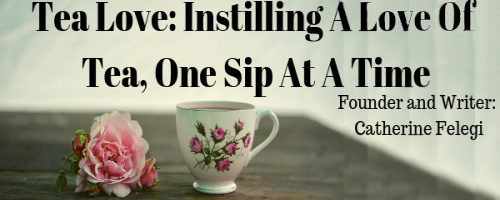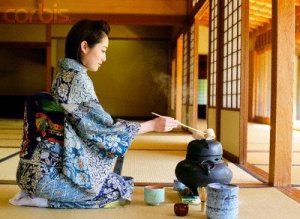History of the Japanese Tea Ceremony:
The Japanese tea ceremony is highly ritualistic. The first records mentioning a tea ceremony was in the eighth century, though it probably did not look like the modern-day tea ceremony. Buddhist monks came out with a book called Cha Ching in order to teach how to properly prepare the tea and use the tea vessels correctly. Today, it is thought that this book helped shape the tea ceremony we now know.
Tea was not readily available to all, being mainly a medicinal drink that later evolved into a drink for the noblemen. Because of the rarity of the beverage, rules and regulations were set on how to drink the tea. In 1187 Myoan Eisai, a Japanese priest, traveled to China to study philosophy and religion. When he came back, he founded Zen Buddhism and built the first temple of the Rinzai sect. Some think that he was the first to start cultivating tea for religious reasons rather than medicinal. He suggested grinding the tea leaves before adding them into the boiling water, known as matcha tea.
The monk met with hostility with the new religion he was introducing, putting him and the tea ceremony at risk. However, he was able to gain protection from the newly converted Kamakura shogunate and was able to keep writing about the tea ceremony. He wrote a book called Kissa Yojoki (“Tea Drinking Is Good for Health”), in which he cites various health reasons to drink tea, including curing loss of appetite, paralysis, boils and sickness from tainted water. Tea popularity grew as more people heard about its amazing properties. The samurai class specifically loved the tea ceremony and spread the popularity further.
When the Kamakura shogunate in 1333, a new class of people came about called the Gekokujou. These noblemen were also enraptured by the idea of tea ceremonies and decided to turn it into a type of game with their friends. The game Toucha challenges drinkers to distinguish between genuine teas and other lower quality teas. People would place bets and the winners would get expensive prices, adding to the excitement of the tea party.
At first, each person was provided a tea-cup. Soon, the tea ceremony parties grew from twenty to thirty to even one hundred people at a time. It would be impossible to provide each person a tea-cup, so attendees would either drink from the same tea-cup and pass it to their neighbor, or they would pass a tea bowl. This also helps to reaffirm the close ties that attendees have with one another.
Tea ceremonies were scaled down again to be for smaller, more lavish groups in a more simplified setting. Zen priest Murata Shukou dedicated his life to the Zen-like tea ceremony and offered instruction to those who wished to learn more. He wanted to serve the tea to his guests, rather than have another, creating an intimate bond with his guests. Simplicity, sober-looking colors, intimacy and types of utensils were all important to Shukou. He became the first chanoyusha, a professional teacher of the tea ceremony.
A wabi-suki is also a teacher of the tea ceremony but he also focuses on faith in the performance of the tea, an ability to act with decorum and excellent practical skills. A meijin has the qualities of a wabi-suki but is also a collector of fine Chinese tea utensils.
The tea ceremony is kept Zen-like and low-key as it was originally designed. Highly ritualistic, the tea ceremony is both complicated, yet simple.
Conducting a Japanese Tea Ceremony:
In order to conduct a Japanese tea ceremony, one needs to concentrate on steps that are simple in their ideas, yet complicated in their execution. You will need:
A tea kettle
Tea cups (if serving the tea in cups, rather than a tea bowl)
A tea bowl (if serving the tea in a communal bowl)
A tea bowl containing the unprepared matcha tea
A tea scoop to scoop the matcha tea
Bamboo ladle for the water
Bamboo whisk to mix the tea
Bamboo rest for the tea kettle lid
Cleaning basin for guests
A wooden stand
Tatami mats (straw mats)
A fine silk cloth the cleanse the tea bowl
A tea cloth to clean the items
Decorations for the room (flowers, candles, paintings, etc)
Sweets to munch on
– Be sure to aspire to a proper tea ceremony. If you do decide to conduct one, make sure that you are dedicated to doing so. You will need to prepare everything ahead of time, display any flowers in a way that they compliments nature, evoke warmth during the winter or coolness during the summer, prepare for any rain if you have it outdoors, make an inviting bowl of tea for your guests and attend to them. Your guests are highly important and should feel as such.
– There are four principles of a tea ceremony that you should try to meet. The wa (harmony), kei (respect), sei (cleanliness of soul and body), and jaku (tranquility) should be on your mind the entire time.
– It is recommended to cure the tea pots and the tea cup that you will be using. Place loose tea into the tea-pot with boiling water and let it sit for the day. To cure the tea cups, put boiling tea into a large bowl and put the tea cups into it for a day. This allows the tea oils to fill the tea cups and tea-pot. However, a typical tea ceremony is with a tea bowl instead. We will be discussing how to conduct a ceremony using a tea bowl, rather than individual cups.
– Find a nice, quiet room to have your tea party. If you can, have it outside in a garden. The Zen nature of the garden will compliment the ceremony.
– While tea ceremony rooms are typically decorated in a certain way, the main idea is to create a warm, welcoming environment for your tea ceremony. Candles and flowers can add a touch of peace to the room. Just be sure to keep everything simple. Your guests will be kneeling, so a tatami mat is encouraged.
– Prepare the tea room before your guests come in. You should bring in your tea set, tea pot, a stone basin for guests to cleanse themselves, a wooden stand to hold everything, your sweets you plan to serve, a bowl to hold the matcha, a portable hearth to keep the tea pot warm and a silk cover for the bowl holding the tea.
– Invite your guests to the tea room by ringing a gong during the day, or a bell during the night.
– Have your guests wash their hands and mouth using the fresh water in the basin. Guide them to the mat after they are cleaned.
– Bring in the tea bowl with the matcha. You should have the tea scoop resting across the bowl. Also bring in the tea whisk and tea cloth. Offer your guests some sweets to munch on while they talk.
– Bring in the waste water bowl, the bamboo ladle and the bamboo rest for the kettle lid. Offer your guests more sweets.
– Use the silk cloth to cleanse the tea container and the tea scoop.
– Ladle some hot water into the tea pot and clean the whisk. When you are finished with the process, empty the tea bowl and wipe it with the tea cloth.
– Place three scoops of tea per guest into the tea bowl using the scoop. Be sure to lift both the scoop and tea container while doing this.
– Ladle hot water from the kettle into the tea bowl. There should be enough water to create a thick liquid with the whisk.
– Return unused water to the kettle using the ladle.
– Pass the bowl to your first guest. The guest should bow when receiving the tea. Rotating the bowl is a sign that the guests are admiring the bowl. Finally, the guest should drink from the bowl, clean the rim and pass it to the next guest.
– After all guests have had some tea, take the bowl and rinse the tea scoop and whisk. Finally, clean the tea container and offer it to the guests to admire.
Photo Credit:
Let’s Learn Japanese. 17 July 2011. japanese_tea2[1].jpeg, 3 Jan 2012. JPEG.
Source Credit:
eHow. “How to Conduct a Japanese Tea Ceremony.” eHow.com, 2012. Web. 3 Jan 2012.


usefull information, thanks. hope you make some more posts soon.
LikeLike
Thanks! I try and post every Wednesday, so stop by and see if you like what you see 🙂
LikeLike
Pingback: Tea Ceremony: Destination China « Tea Love
Pingback: Tea Ceremony: Destination Tibet « Tea Love
Would you mind if I posted this blog post on my web page? I would give you credit and a link back to your website. Many thanks, and if possible let me know here!
LikeLike
You are more than welcome to do so! Have fun 🙂
I also recommend that you look at the websites cited at the bottom of the blog, as they had some amazing information that you might like.
LikeLike
i love your blog, i have it in my rss reader and always like new things coming up from it.
LikeLike
Thank you very much! Feel free to like me on Facebook to get up-to-date information on tea 🙂
LikeLike
Pingback: Zen & the Art of Enjoying Everyday Life : Zen Moments #2 « Ritu’s Weblog
Thank you!
LikeLike
Hi! Do you use Twitter? I’d like to follow you if that would be okay. I’m definitely enjoying your blog and look forward to new posts.
LikeLike
Hi there! I actually do not have a Twitter at the moment. However, Tea Love does have a Facebook that I update regularly. Check it out and make sure that you like me!
Thank you so much for reading.
LikeLike
Keep working ,great job!
LikeLike
Thank you very much!
LikeLike
This really answered my problem, thank you!
LikeLike
You’re welcome!
LikeLike
Pingback: Green Tea Bobas { Homemade } « Tea Love